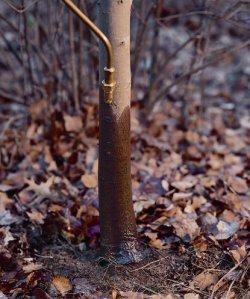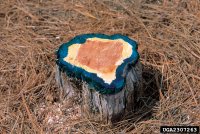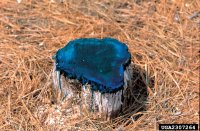Control of Woody Brush Along Fence Rows
The winter months are often seen as a time to suspend weed control efforts. However, this season is ideal for performing some much needed brush control along fence rows.
Persimmon, sweet gum, Chinese tallow, Brazilian pepper-tree and other "weedy" trees can often be found growing along fencerows. Although these brushy species can provide good wildlife habitat, prolonged growth will eventually weaken the fence and make repair very difficult.
Several techniques can be used to remove these species. First, a foliar application of glyphosate (5 to 8% solution) made prior to leaf color change can be effective, but total coverage is difficult and retreatment will often be necessary. Although foliar application is relatively fast and simple, it is often unsuccessful because it is difficult to get enough herbicide into the leaves with a single application to control the entire plant. An alternative application procedure that is more effective and consistent is basal treatment. Basal application combines the herbicide with a penetrate oil (not water) and applies the mixture directly to the bark of a standing tree (Figure 1). This results in rapid uptake and loads a great deal of herbicide into the plant. However, it is important to use a basal oil or diesel fuel/herbicide mix; a herbicide/water solution will simply not work.

The basal technique is for trees that are less than 6-inches in diameter and have smooth bark. It is important that the lower 12 to 18 inches of the stem be treated on all sides with the herbicide/oil mixture. Adequate coverage is essential, since treating only one side of the stem will result in controlling only half of the tree. Basal applications can be made any time of the year, but are most effective during the dormant season when leaves are not present. It must be noted that basal applications will not provide rapid control, but winter applications will generally result in a tree that never leafs out in the spring. It must be noted that basal treatment is not effective on older trees with thick bark. The key to success with basal treatments is spraying smooth bark that the herbicide mix can easily penetrate. Thick/dead bark will provide a barrier that is simply too great for the herbicide to penetrate. For older more mature trees, other application techniques should be employed.
Herbicides that work best for basal application are triclopyr-ester (Remedy Ultra, Garlon 4 Ultra, Tahoe 4, and others) and Stalker. A triclopyr product should be mixed with basal oil to form a 25% solution (1 quart of herbicide in 3 quarts of oil). This product is highly effective on most all woody brush, including Chinese privet. Stalker is a more potent herbicide and only requires the addition of 8 to 12 oz of herbicide per gallon of basal oil.
Another way to control brush to simply cut them off even with the ground. However, trees are simply cut with no other provision made will vigorously resprout in a relatively short time. Therefore, a cut stump treatment can be used to eliminate, or greatly reduce, resprouts from the cut surface. To do this, a herbicide should be applied to the cut surface as quickly as possible, after the sawdust has been removed. If applied immediately, a herbicide/water solution is sufficient. If herbicide treatment is delayed and the cut surface has begun to dry, it is best to recut the stump to expose a fresh surface for treatment.

For stumps greater than 3 inches in diameter, thoroughly wet the outer edge while avoiding herbicide runoff (Figure 2). This is because the only living tissue in larger trees is around the outer edge. Covering the entire cut surface will require more herbicide, most of which will provide little effect. For smaller stems it is appropriate to cover the entire cut surface (Figure 3). For this procedure, herbicides can be applied using a backpack sprayer, squirt bottle, or paint brush. Many herbicides have been found to be highly effective for this use. Glyphosate (50-100% solution), Remedy Ultra (20% solution), Pasturegard (50% solution), or Stalker (8 oz/gal) have all been shown to be effective as cut-stump treatments.
For more information on brush control, please reference Herbicide Application Techniques for Woody Plant Control.


